Diseases Associated With Florida Wildlife
NOTE: To report a sick animal anywhere in Florida, call the Florida Wildlife Commission at 886-293-9282
Report wildlife emergencies to State of Florida Wildlife Alert: 888-404-3922
If they don't answer, you can also call your local sheriff office for sick wildlife emergencies.
Please don't call us! We run a critter removal business, and charge for our services. Thank you!
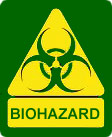 | |
Zoonotic Diseases: Zoonotic diseases are diseases that are transferred from animals to people. While common sense can often prevent transmission of many
diseases, others, such as those transferred through contamination from animal waste, are harder to avoid. Read the below descriptions of various diseases, sorted by common Florida nuisance wildlife species.
Please be careful around any wildlife, and if your home or property has been invaded by wild critters, please take care to avoid the waste these animals have left behind, and consider having your
attic cleaned. I'll start with a list of common wildlife parasites, then discuss each of the common wild animals. |
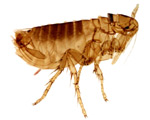 |
Fleas: I commonly encounter fleas in my wildlife removal work. Sometimes it's just an annoying matter of having these parasites bite me. Sometimes the
homeowner with a wild animal in/under the house must deal with an onset of fleas on their pets. The bites are not pleasant, but fleas are also known to carry Murine Typhus Fever, which is caused by Rickettsia
typhi, an organism present throughout FL. Rats are the most common carriers of the disease. Fleas are also implicated in the transmission of Bubonic Plague, which is now rare. |
 |
Lice: Head lice (Pediculus humanus capitis) are parasitic insects found on the heads of people and can host with many types of
wildlife. Lice don't cause any disease, but
most people would prefer not to have lice. It's unlikely to contract lice from a wild animal, but lice are just an example of many types of parasites that wild animals carry that can also choose humans as a host. |
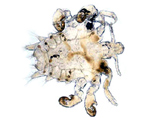 |
Mites: Can be found on a variety of wild animals and birds, and certain species are responsible for causing Sarcoptic mange (Sarcoptes scabei) in humans.
Mites are directly transferred by contact, and result in a spreading scabby exuding and intensely itchy skin lesion, infested with microscopic mites. Scabies is not pleasant, and I know of a colleague who contracted
it, due to exposure to wildlife. These mites may be present on a variety of wildlife species and the areas they inhabit, such as your walls or attic.
|
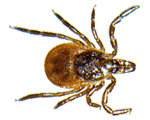 |
Ticks: Are notorious parasites, and found on just about any mammal. They are most well known as carriers of Lyme Disease, which is caused by the
Borreliaburgdorferi bacteria and is transmitted by several species of ticks and fleas. The symptoms generally progress through “flu-like” symptoms such as fatigue, fever, sore throat, nausea and coughing.
Later arthritis sets in, usually in the knee and elbow joints Rocky Mountain Spotted Fever is a disease caused by the bacterium Rickettsia rickettsii. It can be transmitted to people by several species of ticks |
 | |
Raccoon Diseases: Rabies is the most commonly cited disease associated with raccoons. Raccoon Roundworm (Baylisascaris procyonis & B. columnaris) is caused by contact with infected raccoon feces, which can pass the
sticky and durable eggs to humans. Contracting this disease occurs by accidental ingestion or inhalation of the eggs. Infection of humans can lead to larval parasite migration to the central nervous system.
Giardia lamblia is a protozoan causing diarrhea associated with ingesting food or water contaminated by raccoon excrement. Trypanosoma cruzi is associated with raccoon excrement as are
Rickettsia rickettsii, Leptospirosis, and Salmonella. |
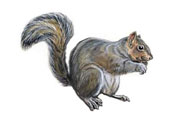 | |
Squirrel Diseases: Squirrels are typically not important vectors of disease - I don't think there's any documented cases of rabies transmission from squirrels,
for example. Like all animals, squirrels can carry parasites, they leave behind excrement, and they can leave both in your attic. Squirrel droppings, like pretty much any wildlife dropping, are associated with
Leptospirosis and Salmonella. |
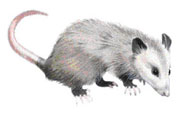 | |
Opossum Diseases: Opossums have a spectacular immune system, and a lower than average body temperature. This means that they don't carry a whole lot of the standard
zoonotic diseases that other animals might carry. Although an opossum might get rabies, it's very unlikely. However, opossums do often carry fleas and other parasites, and the potential diseases that go along
with those. They also defecate, a lot, and when they get in your attic the droppings can contaminate the area and pose the usual excrement health risks, such as leptospirosis or Salmonella. |
 | |
Armadillo Diseases: Armadillos are not really a concern when it comes to infecting people with disease. The only interesting curiosity of note is that dillos
can actually carry and transmit leprosy to humans. Many wild armadillos have been known to be infected with the bacterium that causes leprosy (Hansen’s disease). This is because armadillos have a lower than average
body temperature, at which leprosy thrives. The only way to get it from a dillo is probably through excessive handling or eating of armadillo meat. |
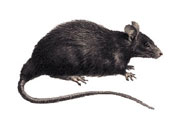 | |
Rat Diseases: The most famous case of zoonotic disease in human history is the Bubonic plague, or “Black Death” of the Middle Ages. This disease is still present today in the US, though
far less common. Over 30 different types of disease are associated with rats and their droppings. They include Rat-bite fever (Streptobacillus moniliformis bacteria), which is transferred from rats to humans by the
bite of a rat. Rickettsia virus can create a condition similar to chicken pox. Hantavirus is outlined below. Eosinophilic Meningitis is an infection of the brain, and caused by rat lung worm angiostrongylus
cantonensis. The droppings of rats can cause Leptospirosis or Salmonellosis. |
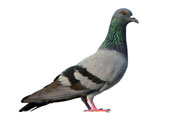 | |
Bird Diseases: Bird such as pigeons can carry a number of parasites and mites, but the most common disease associated with urban pigeon problems is histoplasmosis,
a fungal disease that humans can get by breathing in the fungal spores that can grow on pigeon droppings. I commonly deal with pigeons inside buildings and attics, and they often leave a great quantity of droppings,
which can result in airborne health hazard. Other fungal diseases associated with pigeon droppings include Cryptococcosis and Psittacosis. |
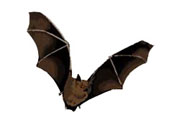 | |
Bat Diseases: Bats are actually the most common transmitter of the rabies virus in North America. This may be due to a number of reasons. First, bats are common
inside homes, and may sneak down a wall and into the living space. Second, bites are small and thus may go undetected, or treated as less severe. Third, some subtle factor, perhaps a variant of the disease or a
concentration in the saliva, seems to make bat rabies more likely to infect people. Bat droppings are also prone to grow histoplasmosis fungal spores, and bat droppings can really accumulate in an attic. |
 | |
Snake Diseases: Most people are more concerned with snake venom than with diseases. However, even a non-venomous snake can cause bacterial infection via its seemingly
harmless bite. All snakes can carry the Salmonella species of bacteria. Contact with snakes has been directly implicated in human Salmonellosis outbreaks, and the snakes typically exhibit no signs of illness themselves.
This said, I don't consider snakes a significant or legitimate transmitter of diseases. |
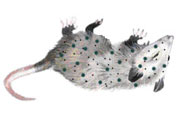 | |
Dead Animal Diseases: I don't know. A rotting animal carcass stinks. You don't want to touch it or get near it anyway. I always wear a HEPA respirator mask
and gloves when dealing with dead animals, and I spray down the area thoroughly with a disinfectant. Oftentimes, hundreds of fleas will still cover a dead animal. I'm sure there's a myriad of diseases associated
with dead animals, but I guess the advice is to have them professionally removed and cremated, like I do. |
Rabies is a viral disease (caused by rhabdovirus) that can infect any warm-blooded mammal, but is usually confined to a few key wildlife species such as raccoons, skunks, canines, and bats. Infection is relatively rare in the United States, due to high levels of awareness of the disease and strong preventative measures
taken here. Worldwide, dogs are the primary cause of infection, but in the US, our animals are well-vaccinated. Of wild animals most people seem to associate raccoons with rabies, but it is actually bats that account
for most cases of infection in the US. The virus attacks the nervous system, traveling from bite site to the brain, where the virus replicates. Once symptoms appear, the disease is 100% fatal. A rabid animal may be very aggressive or lethargic and behave in an unusual manner - random
walking, attacking inanimate objects, no fear of people, no alertness, frothing at the mouth, etc. Many people call me to report a rabid raccoon because it is out during daylight hours. Although a normally nocturnal
animal with rabies may be active during the day, many healthy raccoons are as well. However, definitely do not approach any raccoon exhibiting abnormal behavior, such as erratic
walking, walking in circles, paralyzed hind legs, and other abnormal behavior. Another common misconception I hear from people is that animals always carry rabies and can transmit it at any time. This is not true.
A rabid animal transmits the virus via its saliva, usually by biting, and this contagious stage is brief, during the animal's last few days before death, and is accompanied by the strange behaviors mentioned. A healthy
animal, behaving normally, would not have the virus in its saliva. If you've been bitten by a wild animal, seek medical attention immediately. You may want post-exposure rabies treatment, which includes a shot of
immunoglobulin and some shots of vaccine. The virus usually has an "incubation" period of 2-4 weeks before the fatal symptoms occur. If you have access to the animal that bit you, such as a pet or a bat, you can
send it to a lab for testing.
Histoplasmosis is a respiratory infection caused by the Histoplasma capsulatum fungus. The fungus is often found in soil with high organic and nitrogen content. Infection occurs when spores of the fungus are inhaled.
Histoplasmosis is associated with bat and pigeon roosts, because excrement from these animals provides an ideal environment for the fungus. Histoplasmosis infection may take many forms, and symptoms of the disease are
variable. The commonly symptom is a mild respiratory trouble which may go undiagnosed. However, severe cases resembling tuberculosis also occur. The risk of infection can be reduced by avoiding dust in such areas as bird
roosts and the insides of attics inhabited by birds and bats.
Leptospirosis is caused by the bacterium Leptospira interrogans. It affects a wide variety of wildlife species, including skunks and raccoons. Human cases of leptospirosis usually are transmitted from commensal
rodent populations. In some cases, this disease can be very serious and life threatening. Symptoms include fever, headaches, weakness and vomiting.
Salmonella Bacteria that exist in pretty much all wildlife droppings and several serotypes are pathogenic to humans and other animals. Salmonellosis can lead to severe cases of gastroenteritis, enteric fever
septicemia (blood poisoning), and death. Food poisoning, the most common malady, is characterized by a sudden onset of abdominal pain,
diarrhea, nausea, and vomiting. One common means of transmission is through food
contaminated by rat or mouse feces that contain Salmonella organisms.
Hantavirus is a virus that can cause febrile illness in humans and sometimes kidney, blood, or respiratory ailments, and can sometimes be fatal. The symptoms include fever, headache, muscle aches, nausea, vomiting
and lower back pain. Rodents such as rats and mice are the primary vectors for viruses in this group and these viruses are found across the US. Infected rodents leave viruses in their urine, feces and/or saliva and can
remain chronically infected. The droppings from infected rodents are believed the be the source of both airborn and direct transmission to other rodents and humans.
Bubonic Plague is caused by the bacterium Yersenia pestis and can be found in rodents, most commonly rats. Fleas transmit plague from animal to animal. Early symptoms of bubonic plague include fever, confusion,
and fatigue. Untreated bubonic plague has a relatively high fatality rate
Tularemia (caused by Franciella tularensis) is a severe bacterial disease carried by rodents that is readily transmissible to humans who come into contact with contaminated food or droppings. The organism can penetrate intact undamaged skin. In humans the bacteria rapidly grows in the blood, produces high fever, and can lead to death if it goes undiagnosed and untreated.
Yersiniosis (caused mainly by Y. enteorcolitica in people) is an organism carried by wild birds and mammals that concentrates in water bodies, and people that drink that water can be exposed to very high doses. Yersiniosis symptoms include diarrhea, enlarged lymph nodes in the gastrointestinal tract and an appendicitis-like syndrome.
Read more educational articles about wildlife:
Will the city or county animal services help me with a wild animal issue?
Will repellents get a wild animal out of the chimney?
How to get wild animals out of the chimney
How to keep wild animals out of a chicken coop
What animals chew on electric wires?
Do animals chew on water pipes? What are the risks?
What if you are bitten by a stray cat
What is the best brand of cage trap?
What to do about a cage-shy (hard to trap) wild animal
What are some humane ways to kill a wild animal in a cage?
What is the best bait to trap a wild animal?
Are baby wild animals cute?
How do I know if there are baby wild animals in the attic?
What kind of damage do wild animals cause in an attic?
What are the most common types of animals that live in attics?
How do you know if you have a wild animal in your attic?
Do mothballs or ammonia help repel wild animals?
What should I do with a wild animal after I catch it?
Should I feed a baby wild animal I found?
Is wild animal feces dangerous to touch or breathe?
What is an exclusion barrier?
What equipment is needed to trap a wild animal?
Do wild animals have emotions?
What problems do elephants cause for people?
What are the most common types of animals that eat your pet's food?
What are the most common types of animals that eat your garden?
How do you remove a wild animal stuck in a dumpster?
What is Canine Distemper?
What are the most common types of animals that dig up the yard?
What wild animals can destroy the wood on your house?
What to do with a dead pet dog?
How to get a dead animal out of your car
Is a wild animal that is active during the daytime rabid?
How to get rid of critters in the attic
What is a conibear trap?
How do I clean wild animal feces out of my attic?

I operate a professional wildlife removal business in Orlando Florida. It is not a pest control or extermination company, nor is it the county animal control. It is a privately owned nuisance critter and wildlife
control business. For more company information, just browse this site or give me a phone call, 24/7.
|